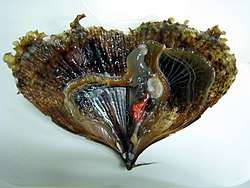Atrina rigida
Atrina rigida, commonly called the rigid pen shell, is a species of bivalve mollusc in the family Pinnidae.
| Atrina rigida | |
|---|---|
.jpg) | |
| Scientific classification | |
| Kingdom: | Animalia |
| Phylum: | Mollusca |
| Class: | Bivalvia |
| Order: | Pteriida |
| Family: | Pinnidae |
| Genus: | Atrina |
| Species: | A. rigida |
| Binomial name | |
| Atrina rigida (Lightfoot, 1786) | |
| Synonyms | |
| |
Description
The rigid shell has a pair of thick spiny valves held together by ligaments that run along the entire dorsal side of the bivalve. The bivalve is triangular with 15 to 25 low ribs radiating from the pointed anterior end (or umbo) to the large posterior edge. The exterior of the shell is usually a dull brownish color with many small tube-like spines along the crest of its radiating ribs. Its anterior end is typically buried in fine substrate and attached by byssal threads, with its wider posterior gaping end extending just above the sea bottom surface to facilitate filter-feeding. Algae (e.g. Lobophora variegata) and invertebrates such as sponges and encrusting corals tend to grow on the exposed part of the shell and may camouflage it very well.


Distribution and habitat
The rigid pen shell can be found in coastal western Atlantic waters, ranging from southern Florida across the Caribbean and the West Indies to Brazil. It is a benthic shallow water species and is typically found in soft-bottom silty habitats, with its narrow anterior end (umbo) burrowed down and attached to underground substrate by its byssal threads. Its wider posterior gaping end extends just above the sea bottom surface to facilitate filter-feeding. Algae, invertebrates such as sponges and encrusting corals tend to grow on the exposed part of the shell and may camouflage it very well.
Filter-feeding
The rigid pen shell burrows as it grows, but the wide posterior end of the shell always remains exposed so water from above the seafloor can be drawn through the inhalent chamber of the mantle cavity. Typical of bivalves, water is drawn over gills or ctenidium by the beating of cilia where oxygen from the water is absorbed. Suspended food and other water-borne nutrients also become trapped in mucus, which is then transported to the mouth, digested and expelled as feces. Unique gutter-like waste canals in the viscera of the inhalent chamber also help to keep gills and other organs clear from silt and other unwanted water-borne particules by expelling these as pseudofeces.[1]
Symbionts
Commensal symbionts such as crustaceans and cardinal fish may be found sheltered inside the shells mantle cavity. This species is preyed upon by starfish, and other carnivorous gastropods, including the horse conch Triplofusus papillosus.
References
- Yonge, C. M. (1953). "Form and Habit in Pinna carnea Gmelin". Philosophical Transactions of the Royal Society of London. Series B, Biological Sciences. 237 (648): 335–374. doi:10.1098/rstb.1953.0006. JSTOR 92484.
- "Stiff Pen Shell". eNature.com. Archived from the original on 2011-05-16. Retrieved 2008-02-01.
- Carpenter, Kent E., ed. (2002). The Living Marine Resources of the Central Western Atlantic (PDF). American Society of Ichthyologists and Herpetologists. Retrieved 2008-02-01. p. 79
- "Guide to Shelf Invertebrates - Gulf of Mexico: Family Pinnidae" (PDF). Retrieved 2008-02-01.
- Grave, Benjamin H. (1909). "Anatomy and Physiology of the Wing-Shell Atrina Rigida". Bulletin of the Bureau of Fisheries. Govt. print. off. xxix. Retrieved 2008-02-01.
- Mitchell, Patricia B. "American Stiff Pen Shell: Strength and Rigidity". Archived from the original on 20 December 2007. Retrieved 2008-02-01.